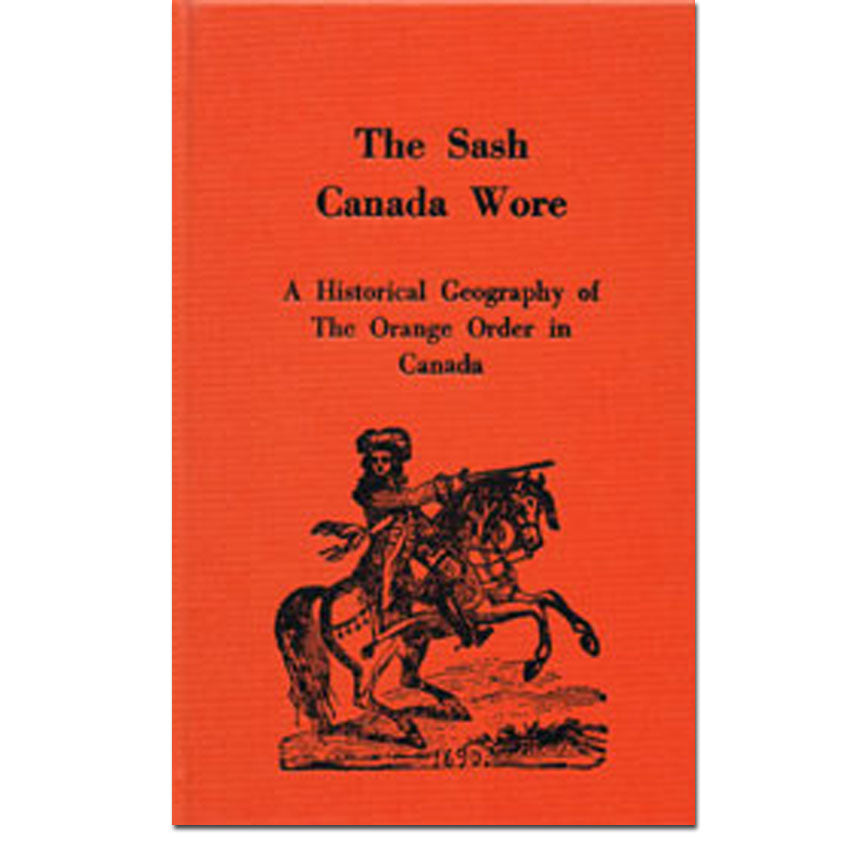Global Heritage Press
The Sash Canada Wore, A Historical Geography of The Orange Order in Canada
The Sash Canada Wore, A Historical Geography of The Orange Order in Canada
Couldn't load pickup availability
By Cecil J. Houston and William J. Smith
This book is essential to understanding the effect of the Orange Order on cultural and political development of Canada throughout the nineteenth and early twentieth century,
Contents include:
- Introduction
- The Irish, British, and Canadian Beginnings
- Irish origins
- Transfer to Britain
- Transfer to British North America
- Orangeism and the Settlement Geography of Central Canada, 1830-1920
- Establishment of the Grand Lodge
- Growth in Ontario
- Geographical spread through Ontario
- Geographical expansion and adjustment in Ontario
- Quebec
- West and East
- Manitoba
- Saskatchewan and Alberta
- British Columbia
- New Brunswick
- Nova Scotia
- Prince Edward Island
- Newfoundland
- Orange Membership: Strength and Composition
- Numerical strength
- Characteristics of the membership: rural and small town
- Toronto Orangemen
- The Social Dimension
- Conviviality
- Ritual and colour
- Discipline
- Self-help and mutual aid
- Orange Mutual Benefit Fund
- The Orange landscape
- The Ideological and Political Dimension
- Imperialism and Orangeism
- National party politics
- Provincial party politics
- Other ultra-protestant movements
- Local politics; Toronto
- The Collapse
- Attrition
- Geographical retraction
- Causes of decline
- The Orange Order in the 1970s
- Conclusions
- Notes
- Bibliography
- List of tables
- List of figures
- List of drawings and photographs
- Index
Background
Although a distinctly Irish creation, the Orange Order, early in its development, was inserted into a British North America that was being opened to British settlers.
Protestant Irish soldiers and emigrants, largely Ulster-born, introduced the organization into New Brunswick, Quebec, and Ontario within the first decade of the nineteenth century. In its zenith, the movement had a membership of as many as one in three Canadians. Successive waves of Ulster emigrants extended the Orange ideals and the order's institutional superstructure to the settlement frontier.
Reviews:
This book traces the fraternal organization from its birth in 1795 in rural Ulster, through its migration overseas, to when it became a major social and political force in the colonies of British North American, now Canada. As a result of media focus on the annual 12 July marches in Ireland, the Orange Order is viewed as strongly anti-Catholic. But the book gives a very different impression, portraying a politico-religious society which defended Protestantism, urged loyalty to the British monarchy and promoted the maintenance of Canada’s constitutional arrangements with Britain.
The Orange Order started in Canada as an Irish immigrant organization but quickly transcended into an integrated Protestant organization. Canadian and U.S. born members were attracted to it as well as Protestants from other ethnic groups. The estimate is that one in three Canadian men belonged. The impact was great, especially on communities in remote areas, where it met many social needs. The Order became an integral part of Canada’s colonial history.
This book describes very well, the rise of the Order in the nineteenth century and its gradual demise in the 1970’s. The Order grew initially in Ontario and moved both north and west as the country developed. Almost totally separate was the development in New Brunswick, Nova Scotia and lastly in Newfoundland.
The numerical strength of the Order is shown by the number of lodges noted on maps of the different provinces. The Order changed as the political environment changed. However, it would not give up its loyalty to the monarchy and this ultimately reduced its significance in most communities.
This book provides good social and historical information about an organization that impacted the lives of many Canadian families. -- By Paul Milner, Federation Genealogical Societies, FORUM Magazine, vol 12, number 1
Details:
226 Pages
6.25 X 9.50"
Notes
Bibliography
Index
Hardcover is temporarily out of print
Originally published by University of Toronto Press, Toronto, 1980
This edition by Global Heritage Press, Milton, 1999
ISBN10 1-894378-31-8, ISBN13 978-1-894378-31-4 [hardcover]
Share


